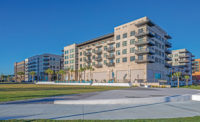City Scoop: Savannah
Industry and Infrastructure Pick Up in Savannah

Hussey Gay Bell is designing a 25-million-gallon-per-day upgrade to Savannah’s Industrial and Domestic Surface Water Treatment Plant.
Photo courtesy The Fortune Image/Hussey Gay Bell

G. Holmes Bell IV
Chairman & CEO
Hussey Gay Bell
For the past 20 years, Atlanta has been the prime location for growth in the region, Bell says, but there has been a noticeable shift toward Savannah as a core market gaining steam in recent years thanks to the Georgia Ports Authority and significant economic development investments.
“Residents and businesses are expanding into bedroom communities and commuting into the metro area, which is driving AEC activity into regions that haven’t experienced significant economic development in decades—whether on the residential or industrial side,” Bell says. “As a result, we’re now playing catch-up, particularly in terms of infrastructure.”
Infrastructure is now the growing region’s top priority, he says, whether water, housing or roads, and all of those areas were concerns before Hyundai announced its monumental construction plans nearby.
In Ellabell, Ga., Hyundai is at work on its Metaplant, which ranked as ENR Southeast’s No. 1 Top Start in 2022, the largest project to break ground that year with a construction value of $5.5 billion. A subsequent expansion for the project tied for the top spot in ENR Southeast’s 2023 Top Starts at $2.5 billion.
Hyundai’s plans to construct its first fully dedicated electric vehicle manufacturing facility and joint venture battery manufacturing facility are set to bring 8,100 jobs to the region, Bell notes.
Hussey Gay Bell is involved in eight related projects, including the $926-million Hyundai MOBIS and the $4-billion Hyundai Motor Group-LG EV Battery Cell Manufacturing Plant.
“We were seeing a large influx of residents from other parts of the state and country, drawn by the quality of life we enjoy here on the coast,” he says, adding that this growth comes with the responsibility to manage it sustainably while balancing the interests of existing businesses and residents.
As a native Savannahian, Bell says achieving that balance is no small feat.
On the residential side, Hussey Gay Bell is seeing significant growth from an increase in planned unit developments seeking approval for an expansion to 100- to 120-lot single-family communities and multifamily housing, he says, as there isn’t enough local inventory to meet the demand of folks moving to the coast.
That has left firms playing catch-up, he adds, with national tract builders quickly moving into the market and bringing affordable housing to the forefront.
“Like many communities in the Southeast, we’re seeing explosive growth at an unprecedented rate, which presents challenges, particularly in terms of infrastructure capacity and housing,” Bell says.
Water in particular is a sensitive topic on the coast, with groundwater withdrawal restrictions leaving the community in a bit of a reactive phase, he says.
“Like many communities in the Southeast, we’re seeing explosive growth at an unprece-dented rate.”
—G. Holmes Bell, Chairman & CEO, Hussey Gay Bell
The city is working on—and Hussey Gay Bell is designing—an upgrade to its Industrial and Domestic Surface Water Treatment Plant to increase its capacity to 75 million gallons per day from 50 MGD to enhance reliability and fire protection.
“I have no doubt that those of us living and working in Savannah and the surrounding areas are approaching these challenges with Southern grace and optimism,” says Bell. “We recognize that this is a pivotal moment, with all eyes on the coast, [including] the attention of those who influence regulations, funding and outcomes. After all, we are the Hostess City.”
All that is adding up to create an exciting time for Hussey Gay Bell’s Savannah headquarters, established in 1958. The firm is involved with major developments for the Georgia Ports Authority, the Huyndai plant as well as infrastructure, housing, education and health care facilities supporting that growth.
“The past five to six years have been incredibly busy for our firm, particularly in the industrial sector, with a strong focus on warehouse, distribution and logistics facilities,” Bell says.
In that time, Hussey Gay Bell has consistently designed 5 million to 6 million sq ft of warehouse facilities annually, he adds, and while that activity is tapering off, interest is shifting toward smaller facilities of 300,000 sq ft or less.
“While we are noticing a slight slowdown in this space, the industrial uptick on the manufacturing side has greatly increased with many of the Tier 1 supplier manufacturing facility locations related to Hyundai Motor Group Metaplant America,” Bell says.




